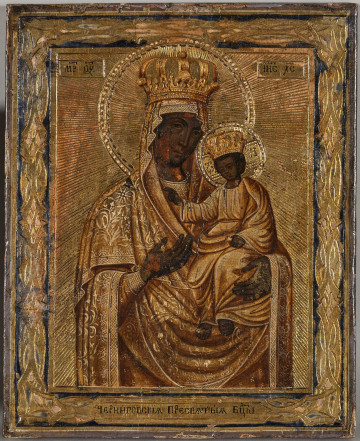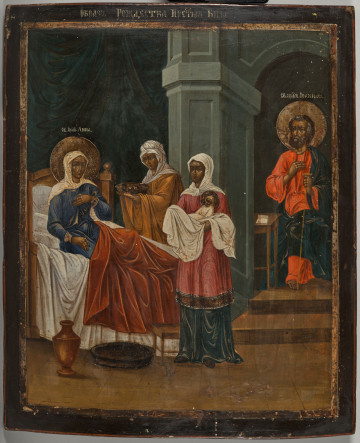
The Mother of God of Hodigitria
19th (?) century
Castle Museum in Łańcut
Part of the collection: Ikony
Pantocrator [Christ the Great High Priest]. According to the conciliar canons of Eastern Christianity, in sacred art God was represented only in the person of Christ, who was the Incarnate Word, co-eternal with the invisible Father (J.14,9-10; Col.1,15). The oldest images depicting the omnipotence and divine nature of the Saviour include those of Christ personifying the Lord of all creation, or Pantocrator in Greek. The Saviour began to be depicted as Lord of the Universe, modelled on an earthly ruler, with all the signs of dignity, in the 4th–6th centuries. There are three variants of the representation of the Pantocrator. He is shown standing in full form, seated on a throne, as in the presented icon, and in later iconography – in bust. The fingers of the right hand raised to breast height are usually arranged in the shape of a monogram of the Christ’s name IC XC. This arrangement can be read simultaneously as a symbol of the dual divine-human nature of the Saviour and the Trinity. A particular type of representation is the image of the Pantocrator on throne, shown in the priestly robes of a dignitary. This representation refers to the Old Testament writings in which Christ is called King and Priest (Ps 110) and the explanatory New Testament texts, e.g. in the Letter to the Hebrews there is an extensive justification of the title of High Priest given to the Saviour (Heb 4:14; 5:1-10). On the icons, Christ the Great High Priest sits on a throne with the Gospel book open, dressed in the outfit of an Eastern clergyman, which consists of a mitre, red sakkos and a golden omophorion decorated with crosses, all visible on the icon in question. This way of depicting Christ can also be found in other variants of representations of the Pantocrator, for example in the images of the King of Kings, where the Mother of God and John the Baptist adore the Saviour on either side, as in the classical representations of Deesis (see S.12824MŁ). Teresa Bagińska-Żurawska https://orcid.org/0000-0002-9243-3967
Dimensions
height: 70 cm, width: 55.5 cm
Object type
Icons
Technique
gilding, tempera
Material
gold, tempera, wood
Origin / acquisition method
decyzja administracyjna
Creation time / dating
Owner
Castle Museum in Łańcut
Identification number
Location / status

19th (?) century
Castle Museum in Łańcut

1800 — 1899
Castle Museum in Łańcut

1800 — 1899
Castle Museum in Łańcut
DISCOVER this TOPIC
National Museum in Lublin
DISCOVER this PATH
Educational path